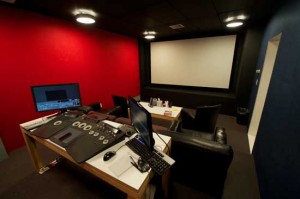
Formerly located in Soho, The Room has recently provided finishing services for film and television projects including Eugene Jarecki‘s The House I Live In, Martin Scorsese‘s George Harrison: Living in the Material World, Kenneth Lonergan‘s Margaret and the BBC‘s Why Poverty? The Room recently completed work on two films for producer/director Alex Gibney, WikiLeaks and History of The Eagles, both of which debuted at the 2013 Sundance Film Festival.
In its new site, The Room will have more space, a stunning aesthetic environment and state-of-the-art technology. It will also enjoy immediate access to the resources and services of Technicolor – PostWorks – the largest postproduction facility in Manhattan – while continuing to provide its clients with personalized attention.
“This company was established to nurture independent film,” said editor Ben Murray, principal of The Room. “We have created a space that can serve the needs of any director and any production, even those requiring heavy editorial, effects and grading.”
“We are delighted to be partnering with Ben and his staff to help maximize the resources and creative vision of this talented group of people and their clients,” said Alastair Binks, president, Technicolor – PostWorks, New York.
The Flame Premium workstations are housed in three editorial/grading suites, one of which is set up as a theater with a 4K Christie projection system. The rooms are light- and sound-isolated to provide ideal environments for finishing. A 10 gigabit Ethernet network links the suites not only to each other, but also to the main Technicolor – PostWorks facility so that projects can move as needed, quickly and seamlessly. The facility has been engineered to accommodate all digital camera formats natively.
Aesthetically, the facility offers a handsome and relaxed environment, with a number stylistic flourishes applied by Segal. Back-painted glass walls give the space the look of a modern art museum rather than a traditional post house. Pinholes in the ceilings of two of the finishing suites create camera obscura effects with images of the exterior streets projected onto client tables.
“When you are working on a film, you need to be in a room that is enclosed and private with no extraneous distractions,” Murray noted, “but when you leave that environment, you want to step out into a world that is more inviting. We’ve created a space that offers balance. Its public space is filled with natural light, but at any moment you can leave that space and return to your own world.”
Along with Murray, The Room’s staff includes colorist Jack Lewars, conform and visual effects artists Ryan McMahon and Allie Ames, and production coordinator Debora Lilavois.





